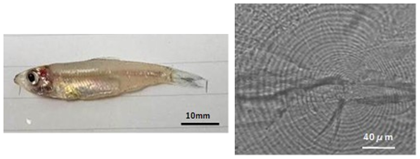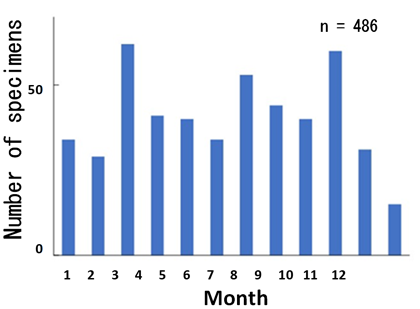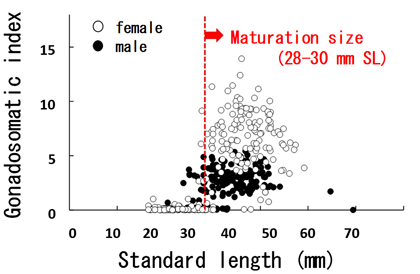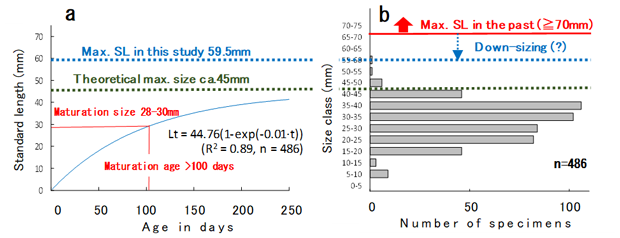Biological information contributing to resource conservation of the important Laotian food fish Pa keo
Description
Pa keo (Clupeichthys aesarnensis), a small-sized clupeid fish (Fig. 1) that is widely distributed in the Indochinese Peninsula, is an important food fish over the area, including Laos. It is captured in great quantities mainly from large-scale man-made reservoirs such as the Nam Ngum Reservoir in Laos, and consumed as dried/fermented fish. In the recent decade, overexploitation/stock decline of this species as a food resource has become a matter of great concern, hence resource management is required.
Based on the above background, we attempted to investigate the population dynamics of Pa keo in Nam Ngum Reservoir by clarifying several biological features (e.g., the age in days and reproduction) in order to propose applicable resource management approaches for the species.
To determine the age in days by individual specimen, we analyzed the daily increments in the otolith (sagitta) (Fig. 1). On the basis of age information by individual specimen, we estimated the hatch month of each specimen and confirmed the year-round breeding of the species in the reservoir (Fig. 2). The relationship between gonadosomatic index [GSI = (weight of ovary/testis) / body weight × 100] and standard length (SL) indicated that the minimum maturation size was 28-30 mm SL for both females and males (Fig. 3), and the growth pattern was regressed by the von Bertalanffy growth curve [Lt = 44.76·(1-exp(-0.01·t)), R2 = 0.89, n = 486] (Fig. 4a). Based on this growth model, the theoretical maximum size of Pa keo population in the reservoir was estimated to be ca. 45 mm SL, and ages reaching first maturation (28-30 mm SL, Fig. 3) were estimated to be over 100 days old (Fig. 4a). In the analyzed specimens (n = 486), the specimens of 30-40 mm SL were the greatest in number followed by the ones of 20-30 mm SL (Fig. 4b). Although the maximum size of the species was reportedly over 70 mm SL, a limited number of specimens were over 50 mm SL in this study (0.4% of analyzed specimens). Considering this size distribution and the theoretical maximum size observed in this study (Fig. 4), the individual maximum size in this population was considered to become smaller over time. This down-sizing is considered the “evolutionary down-sizing” caused by consecutive catches of larger specimens and/or over-exploitation in the population, suggesting the necessity of Pa keo resource management in Nam Ngum Reservoir.
Since Pa keo breeds year-round (Fig. 2), setting up a “non-fishing area” is considered a more efficient manner of resource conservation than setting up a “non-fishing period” from the aspect of conserving the breeding population. In addition, in order to control the increasing fishing effort (i.e., number of fishermen and fishing gears), implementation of a fishing license system and/or a fishing restriction/gear control system should be considered.
Figure, table
-
Fig. 1. Adult Pa keo (40 mm SL) (left) and daily increments in otolith (right)
-
Fig. 2. Hatch month distribution
-
Fig. 3. Relationship between SL and GSI
-
Fig. 4. Growth model of Pa keo population (a) and size frequency distribution (b)
- Affiliation
-
Japan International Research Center for Agricultural Sciences Fisheries Division
- Classification
-
Technical A
- Research project
- Program name
- Term of research
-
FY2018 (FY2016-FY2020)
- Responsible researcher
-
Morioka Shinsuke ( Fisheries Division )
KAKEN Researcher No.: 40455259Marui Junichiro ( Biological Resources and Post-harvest Division )
MIERUKA ID: 001765 - ほか
- Publication, etc.
-
https://doi.org/10.1007/s12562-019-01319-x
Morioka S et al. (2019) Fisheries Science, 85:667-675
- Japanese PDF
-
2019_C06_A4_ja.pdf850.15 KB
2019_C06_A3_ja.pdf262.16 KB
- English PDF
-
2019_C06_A4_en.pdf383.66 KB
2019_C06_A3_en.pdf322.38 KB
- Poster PDF
-
2019_C06_poster_fin.pdf461.95 KB




